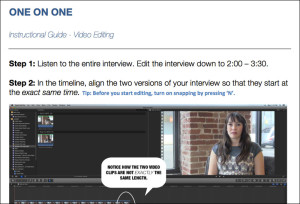Updating the Missouri Method with Rapid Iteration, Multiplatform Delivery
By Jim Flink
This is the second installment of Jim Flink‘s coverage of his new multiplatform experiment at the Missouri School of Journalism. Check out his opening piece that ran in February. Originally published to PBS MediaShift; used by permission.
What causes species to migrate? Inhospitable conditions? A yearning for home? A longing for greener pastures?
In the case of multiplatform migration in news, it’s quite possibly a combination of all three. The conditions that once supported robust life are rapidly degenerating for television and radio affiliates and newspapers alike. Those conditions are urging journalists to reinvent themselves within a better ecosystem.
From the Ground Up
At the Missouri School of Journalism, innovation and entrepreneurship are taught alongside other necessities of journalism training. The Missouri Method of learning by doing requires just such a mindset. My employer, the Donald W. Reynolds Journalism Institute, is engaged in researching, measuring and fostering the adoption of, and adaptation to, the breathtaking pace of change in our industry.

This semester I’m teaching a class in emerging technologies, partnering with six Missouri School of Journalism newsrooms – KOMU-TV, KBIA-FM, Global Journalist, Investigative Reporters and Editors, Missouri Business Alert and Treepple – to build out a stratum of multiplatform content that accelerates the learning and adoption curve. It’s not a destination course. It’s more like a journey.
To quote our textbook, “Searchlights and Sunglasses: Field Notes from the Digital Age of Journalism” by Reynolds Fellow and the Knight Foundation’s Eric Newton, “What you won’t find here is a final answer to the question of the future of news because there isn’t one. Like democracy itself, professional journalism is a somewhat messy experiment.”
That’s because the experiment of optimizing “mobile-first” and multiplatform delivery systems requires many modifications: infrastructure, innovation, workflow/mindset, content creation and distribution, audience, analytics, monetization and more. With each newsroom, the challenges encountered can be culturally specific, content-specific, platform-specific or all three.
SWOT in Need of SWAT
The SWOT business planning structure is a great place to start. SWOT is an acronym for assessing an organization’s Strengths, Weaknesses, Opportunities and Threats. The goal? Identify internal and external factors that may aid in, or prevent, the achieving of larger objectives. While all newsrooms may not be formally engaged in SWOT, they certainly understand the looming threat.

In our newsrooms, we’ve assigned vertically integrated, advanced-level students in small groups of two to four, called SWAT teams, to work on issues uncovered by the SWOT analysis. Tactical and carefully chosen for their capabilities, these small teams are vertical and modular: vertical in their skill set, they can write, edit, shoot video and handle nearly every step of the editorial/production process; modular, in that they also bring together diverse outside skills, learned in their various curricula. Those skills vary from Web (HTML, wireframe capabilities, etc.), to design (Adobe Creative Suite, InDesign, etc.), to a full knowledge of creating editing templates (Final Cut Pro, Motion, etc.) and an understanding of audience/analytics. Each team not only creates infrastructure to address a newsroom’s previously unmet needs, but also creates guides and manuals for future newsroom teams to follow.
Each student has also been imbued in a vast array of strategic social media tools and methodologies. These students see the value of each individual social media platform, not as some giant pool, but rather as individual tributaries that flow from and into the larger collective. As such, they have an understanding of what each social platform can contribute, strategically, to the larger information objective.
Rapid-Iteration Morphing
All these newsrooms have had previous sustained success in integrating content to various platforms. But this class has set as its objective a higher arc and a faster learning curve. We are seeking to create a rapid-iteration model where these SWAT teams integrate a replicable, multi-platform strategy at warp speed. The goal isn’t just to load and deploy content, but rather to place the optimal content to the appropriate platform at the right time, seeking to create a measurable user experience that drives engagement and return visits. In effect, this requires our team members to have a decent understanding of outcomes, and clarity of process, before even embarking on the journey.

When we began the semester, our 18 students were cautioned: We would bump our heads and skin our knees. Often. Rapid-iteration morphing of content is not for the faint of heart. At times, we’ve missed our own self-imposed targets and deadlines. And we’ve also been slower to integrate some of these SWAT team strategies into the larger newsrooms than we had intended. We’ve also had successes:
In just five weeks, Treepple, a targeted marketing health initiative, has created the infrastructure and workflow to rapidly iterate 12 different versions of a particular health video story. Our SWAT team of three students is able to create customized health videos for specific patients on specific health topics of interest in a matter of hours.
Our team at IRE is taking archived assets dating to 1979 as well as real-time content, creating a matrix of distribution strategies to enhance membership in IRE, and deliver content to the multiple platforms that journalists use every day. We also have a separate IRE SWAT team redesigning and optimizing content to core platforms.
Global Journalist is using our team to build out video assets, rapidly populate new social media endeavors, provide enriched content (timelines, infographics, slideshows, etc.) to the website and more. The result is an enriched experience, in real time, in multiple locations.

All six newsrooms are actively engaged in multiplatform strategies they had heretofore been unable to achieve, due to bandwidth restrictions and a lack of appropriate resources.
At the end of our collective 16-week experience, we intend to have portfolios, workbooks and guides, created in real-time, to systemically address our rapid-iteration model of multiplatform video and content distribution so that it can quickly be adopted by and adapted to other newsrooms. These guides will help those who come after us know the shortcuts to the destination. We also intend to have a catalog of rich multiplatform content to document our journey, small steps and giant leaps alike.
After all, a species migrates not just en masse, but also in small numbers at a time. Ours is a Darwinian combination of mobilization, migration and metamorphosis: adopting and adapting rapid real-time content and distribution strategies to both mirror and mold present consumer behavior and to model the newsrooms to come.
Jim Flink is working with the Reynolds Journalism Institute (RJI) at the Missouri School of Journalism, focusing on best practices in mobile, video news content and production, as well as distribution and monetization strategies. During his previous four years as vice president of News Operations, and then general manager of Newsy, he led, coached and cultivated a young startup newsroom into an established, strong, internationally respected newsroom publishing quality video content on emerging digital platforms.
Updated: July 22, 2020